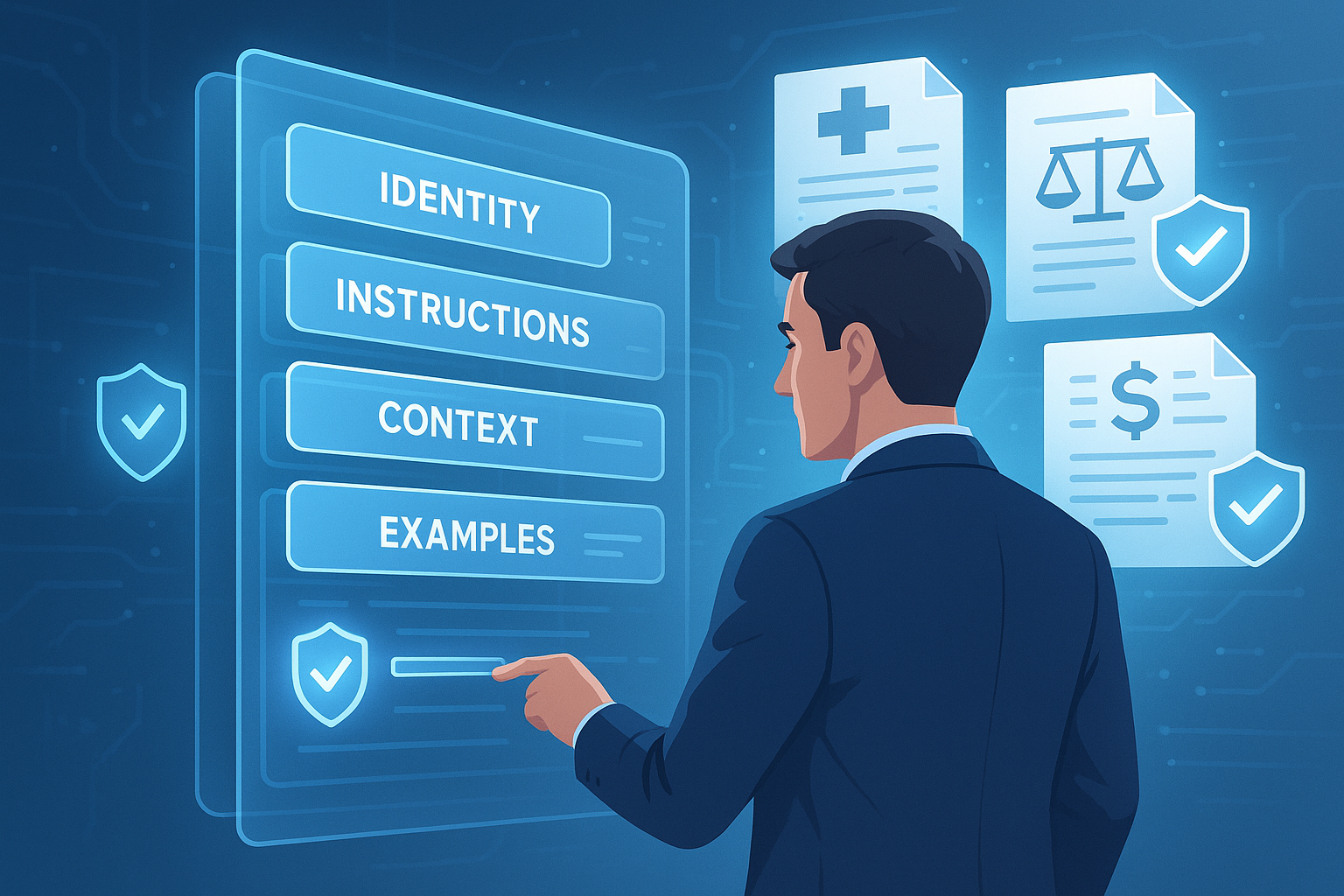
Prompt Engineering 2025: Principles, Techniques & Frameworks for Reducing Hallucinations in High-Stakes AI
Caiyman.ai Research Team
AI Solutions Architect
In 2025, AI’s success in high-stakes industries hinges on one game-changing factor: prompt engineering that dramatically reduces hallucinations and maximizes trust. As business, healthcare, finance, and public sector organizations embed large language models (LLMs) into core operations, the cost of a single AI error—from misdiagnosis to regulatory fines—can be catastrophic. Recent research shows that expertly engineered prompts now cut hallucinations by up to 76% while boosting decision quality, compliance, and productivity (ProfileTree, 2025). Let’s explore the frameworks, techniques, and tools that are defining AI reliability in this new era.
AI’s Dependence on Reliable Prompting in 2025
AI isn’t just doing paperwork or first-pass screening anymore—it’s now directly impacting diagnoses, trading portfolios, government policy, and much more. The reliability of every LLM output is a matter of real-world risk, regulatory exposure, and brand trust. Hallucinations—when models output plausible but false information—can lead to immediate financial, legal, or health crises (Preprints, 2025). As LLMs become more central to enterprise workflows, prompt engineering has shifted from niche practice to foundational discipline for responsible AI (Lakera AI, 2025).
Prompt Engineering Principles: Foundations for Reliable AI
Prompt engineering is both a science and an art—guiding non-deterministic models to produce accurate, consistent, and auditable outputs. The best practices now dominating the field include:
- Iterative Optimization: Start simple, evaluate outputs, then iteratively add explicit context, instructions, and examples to reduce ambiguity (OpenAI Prompt Engineering Guide).
- Explicit Context Inclusion: Use up-to-date or domain-specific data retrieved in real-time (RAG) to overcome model knowledge gaps and ground responses (OpenAI Optimizing LLM Accuracy).
- Clear Tasking and Few-Shot Learning: Explicit instructions complemented by relevant input-output examples (“few-shot”) help the model understand required logic or structure.
- Role and Message Hierarchy: Assign developer, user, and assistant messages to clearly separate system rules, task details, and model completions, giving higher priority to system/“developer” instructions.
- Prompt Caching and Versioning: Standardize and reuse prompt templates to ensure output consistency, reduce costs, and enable rapid rollback when errors or regulatory changes arise.
Prompt structure directly shapes model accuracy and hallucination rates: Logical sectioning (identity, instructions, context, examples), Markdown/XML formatting, and step-by-step “chain-of-thought” reasoning all guide LLMs toward greater reliability (InfoQ, 2025).
Blueprints of Effective Prompt Structure and Advanced Techniques
2025’s leading frameworks embody several advanced architecture patterns:
- Anatomy of an Effective Prompt:
- Identity: State the assistant’s persona and expertise (e.g., “You are a financial compliance officer...”).
- Instructions: Direct output format, tone, constraints (“Provide tax advice using only verified regulations…”).
- Examples: Show ideal input/output pairs to drive generalization.
- Context: Inject real-time or proprietary data via RAG mechanisms.
- Logical Segmentation: Use Markdown/XML sections to clarify transitions and delimit input sources, constraints, or examples.
- Few-Shot & Zero-Shot Prompting: Employ specific or minimal examples to tailor for high generalization (zero-shot) or precise tasks (few-shot).
- Chain-of-Thought (CoT) Reasoning: Encourage stepwise logic to solve complex problems and reduce model “guessing”—especially valuable in domains like legal or diagnostics.
- Retrieval-Augmented Generation (RAG): Combine LLM generation with indexed retrieval from current legal codes, financial statements, or medical databases for grounded, auditable outputs (Preprints, 2025).
- Guardrails, Critics, and Fallbacks: Post-process outputs with validation filters, external model “critics,” or rule-based handoffs to humans when uncertainty or risk is detected (Lakera AI, 2025).
Case Studies: Deploying Prompt Engineering in High-Stakes Realities
Successful deployments illustrate the transformative impact:
- Healthcare – ICD-10 Coding with Ambience Healthcare: Automated prompts for clinical audio/EHR processing coupled with rigorous grading raised coding accuracy 12 points, cutting errors by 25% compared to expert clinicians. Hallucinations were sharply curtailed by systematic prompt refinement and real-world context injection (OpenAI RFT Use Cases).
- Legal – Harvey Platform: Extracted evidence from voluminous documents with precise citation prompts, outperforming previous models—essential for due diligence and compliance (OpenAI RFT Use Cases).
- Finance – Accordance Tax Analysis: Fine-tuned prompts enabled deep reasoning over tax law, nearly 40% higher performance, saving thousands of analyst hours.
- Technical APIs – Runloop: Improved code generation for Stripe integrations by 12% using reinforcement-graded prompts.
These cases reveal that disciplined, eval-driven prompt engineering not only reduces hallucinations but also demonstrably lifts business ROI and safety.
Best Practices, Iterative Refinement, and Frameworks for 2025
- Systematic Evaluation and Iteration: Build eval sets with real-world inputs/outputs. Use metrics and peer review to detect errors and guide prompt refinement cycles (OpenAI Model Optimization Guide).
- Prompt Versioning & Rollback: Pin production prompts and model snapshots, enabling traceability and rapid correction if hallucinations or compliance risks surface.
- Prompt Caching & Performance: Cache stable prompt templates to reduce inference costs and latency in high-volume workflows.
- Guardrails & Model Critics: Integrate automatic output validation (pattern filters, fact-checkers, or human-in-the-loop review) for sensitive legal/medical deployments (InfoQ, 2025).
- Security and Compliance: Defend against prompt injection (input sanitization, consistent delimiters), maintain audit trails, and ensure outputs meet regulatory requirements (Lakera AI, 2025).
The Future of Prompt Engineering: Skills, Responsibility, and Next Steps
Prompt engineering is rapidly merging with core AI Ops, security, and compliance disciplines. In high-stakes sectors, it’s now a job skill as critical as data engineering or security analysis. Continuous evaluation, operational rollbacks, and guardrails are required for responsible AI maturity. As new models and tools emerge, cross-disciplinary upskilling remains crucial to sustain risk-mitigated, value-generating LLM use (ProfileTree, 2025).
Partner with Caiyman.ai for Bulletproof Prompt Engineering and Responsible AI
Ready to unlock reliable, world-class AI? Contact Caiyman.ai for end-to-end best practices—training, audits, prompt design frameworks, risk mitigation, and LLM deployment oversight. Accelerate trust, compliance, and performance across your high-stakes AI applications with our expert support.
Sources
- InfoQ – Beyond the Gang of Four: Practical Design Patterns for Modern AI Systems (2025)
- OpenAI Prompt Engineering Guide
- OpenAI Model Optimization Guide
- OpenAI Optimizing LLM Accuracy
- Lakera AI: The Ultimate Guide to Prompt Engineering in 2025
- ProfileTree: Prompt Engineering in 2025
- Comprehensive Review of AI Hallucinations: Impacts and Mitigation Strategies (2025)
Share this article
Related Articles

How AI Agents and Automated Workflows Are Transforming Commercial Real Estate Appraisals in 2025
Discover how AI agents and workflow automation are revolutionizing commercial real estate appraisals in 2025, driving efficiency, accuracy, compliance, and strategic value for institutional stakeholders.

AI Agents in Banking and Finance: Powerful Innovations Transforming 2024–2025
AI and agent-based workflows are reinventing automation and decision-making in banking and finance for 2024 and 2025. Discover how adaptive models, innovative startups, and agentic architectures are powering the new era of risk management, customer service, financial advisory, and fraud prevention.

AI Sales Agents Transform Real Estate: $4M Uniti AI Funding Signals Industry Revolution
Uniti AI's $4M funding signals a major shift toward AI-powered sales agents in real estate, promising to automate 37% of CRE tasks and deliver $34 billion in efficiency gains by 2030.